

HAMANISHI Katsunori (浜西勝則)
Born in Hokkaidô, Hamanishi graduated with an art degree from Tôkai University, Tokyo in 1973. He submitted his works to international juries, with much success, winning various prizes, including awards at the Ibiza International Print Biennale (1978), the Grenchen International Triennale in Switzerland (1982), and the Valparaiso International Exhibition in Chile (1989). His works are in a large number of major museum collections around the world. Influenced by Yamaobe Yoshio (born 1936), Hamanishi has explored some of the quieter, darker qualities of the mezzotint, Much of his work contrasts representational forms of wooden objects, ropes, or branches with color forms. In others, wrapped man-made objects or natural forms emerge from a mysterious darkness. The titles he assigns to his works are often metaphysical, with terms such as "silence," "calm," "situation," "horizon," "connection," "link," and "division."
The image at the top right (Division-Work No. 20) is a color mezzotint, with relief printing through collagraph (lit., "glue drawing," relief printing from layered or built-up surfaces on a plate or other rigid matrix). It was printed in 1990 for an edition of 50; the image measures 594 x 447 mm (sheet size, 752 x 530 mm). The subtle richness of the mezzotint is difficult to appreciate in such a small illustration as here, where the color-fields emerge and float on either side of a diagonally positioned rope. The print on the left (Division-0) is a color mezzotint printed in 1994, also in an edition of 50. The image measures 280 x 288 mm (sheet size, 467 x 380 mm). This example is characteristic of Hamanishi's segmented compositions, made particularly effective by the asymmetry and varied positioning of the panels and the changing tonality of each rectangle. Among his stylized landscapes are several diptychs is the very large (image 915 x 650 mm) "Silence Work no. 5" from 2003. Several techniques are on display here. The middle wave of wild rice grasses has been executed in a precisionist linear manner, whereas the green hills at top and bottom are rendered with a soft bokashi ("shading off": 暈), each displaying Hamanishi's impressive technical skills. The gold leaf used for the clouds evokes traditional Japanese screen paintings.
In more recent years, Hamanishi has explored images of textiles rendered in mezzotint. Some of these elegant and technically impressive works are large polyptychs, such as kimono — Four seasons from 2012, whose image sizes are each 605 x 450 mm, with paper sizes averaging 755 x 510 mm, in an edition of 75 (see image below). The middle panel includes powered gold. Given the demanding nature of the mezzotint technique and the large format of the three panels, it is not surprising that Hamanishi needed four months to complete the edition.
In 2012, Hamanishi had a two-person show, "The Art of Darkness," with Hamaguchi Yozo (浜口陽三 1909-2000) at the Arthur M. Sackler Gallery, Smithsonian Institution, Washington, D.C. In its promotional text, the museum stated, "The works highlight the visceral production process and show remarkably innovative uses of the traditional European technique of mezzotint in the hands of Japanese artists." From October 12, 2013 until January 5, 2014, the Art Institute of Chicago (AIC) held a solo exhibition for the artist. With that exhibition the AIC celebrated a 2013 gift of works by Hamanishi from the private Landy Collection, making the AIC's assemblage of Hamanishi's prints the largest in the world. Then, from September 27, 2014 until January 19, 2015, Hamanishi's work was included in the exhibition "Kimono: A Modern History" at the Metropolitan Museum of Art, New York. Permanent collections of Hamanishi's work include the Art Gallery of New South Wales, Australia; Art Institute of Chicago; British Museum, London; Fine Arts Museum of San Francisco (Achenbach); Krakow National Museum; Library of Congress, Washington, DC; Museum of Modern Art, New York; National Museum, Osaka; Philadelphia Museum; Taipei Fine Arts Museum; and University of Alberta, Canada. © 2020 by John Fiorillo BIBLIOGRAPHY
|
Viewing Japanese Prints |
 Hamanishi Katsunori (浜西勝則), born in 1949, is one of the foremost practitioners of the mezzotint. The demanding technique required of this intaglio method has appealed to a number of Japanese artists, most notably Hamaguchi Yozo (浜口陽三: 1909-2000). The Worchester Art Museum held a two-person exhibition featuring these artists in 2004. They shared an interest in the exploration of subtle and complex chromatic tonality that is elevated to a thematic level, alongside the objects or forms depicted in the compositions.
Hamanishi Katsunori (浜西勝則), born in 1949, is one of the foremost practitioners of the mezzotint. The demanding technique required of this intaglio method has appealed to a number of Japanese artists, most notably Hamaguchi Yozo (浜口陽三: 1909-2000). The Worchester Art Museum held a two-person exhibition featuring these artists in 2004. They shared an interest in the exploration of subtle and complex chromatic tonality that is elevated to a thematic level, alongside the objects or forms depicted in the compositions. Hamanishi has produced polyptychs as well as single sheets upon which an otherwise continuous composition is divided into panels. Separation is another of his themes, as in his various "Division" series. Recently his palette has brightened a little, especially with the addition of gold, silver, copper, and lead foil to some of his compositions, many of which are more representational in subject matter than much of his earlier work. Views of stylized moonlit landscapes or sunrises also appear in his oeuvre.
Hamanishi has produced polyptychs as well as single sheets upon which an otherwise continuous composition is divided into panels. Separation is another of his themes, as in his various "Division" series. Recently his palette has brightened a little, especially with the addition of gold, silver, copper, and lead foil to some of his compositions, many of which are more representational in subject matter than much of his earlier work. Views of stylized moonlit landscapes or sunrises also appear in his oeuvre.
